
For this edition of Classic Steel, we are going to take a look back at the second generation of Honda’s revolutionary CRF450R.
 In 2005, Honda introduced the second generation of their revolutionary CRF450R to rave reviews. Lighter, leaner, and more competitive than ever, these mid-2000s Hondas showed the world just how good a four-stroke motocrosser could be. Photo Credit: Honda
In 2005, Honda introduced the second generation of their revolutionary CRF450R to rave reviews. Lighter, leaner, and more competitive than ever, these mid-2000s Hondas showed the world just how good a four-stroke motocrosser could be. Photo Credit: Honda
The mid 2000s were a point of major transition within the sport of motocross. Initially, the arrival of the revolutionary Yamaha YZ400F four-stroke in 1998 had not signaled doom to the fortunes of the venerable 250 two-stroke. For all of its many virtues, the original YZ400F was not omnipotent against its rivals. It offered phenomenal torque and a silky-smooth delivery but was also saddled with XR-like weight and a myriad of small annoyances that made it a love-it or hate-it affair for many. The YZF’s annoying starting drill, portly feel, and propensity to bog unexpectedly made it a bit of an acquired taste to a generation of racers bred on light and lithe two-stroke machines. While the YZ400F and YZ426F proved to be extremely popular, their many four-stroke peccadillos prevented them from taking over the sport in the way many pundits had feared.
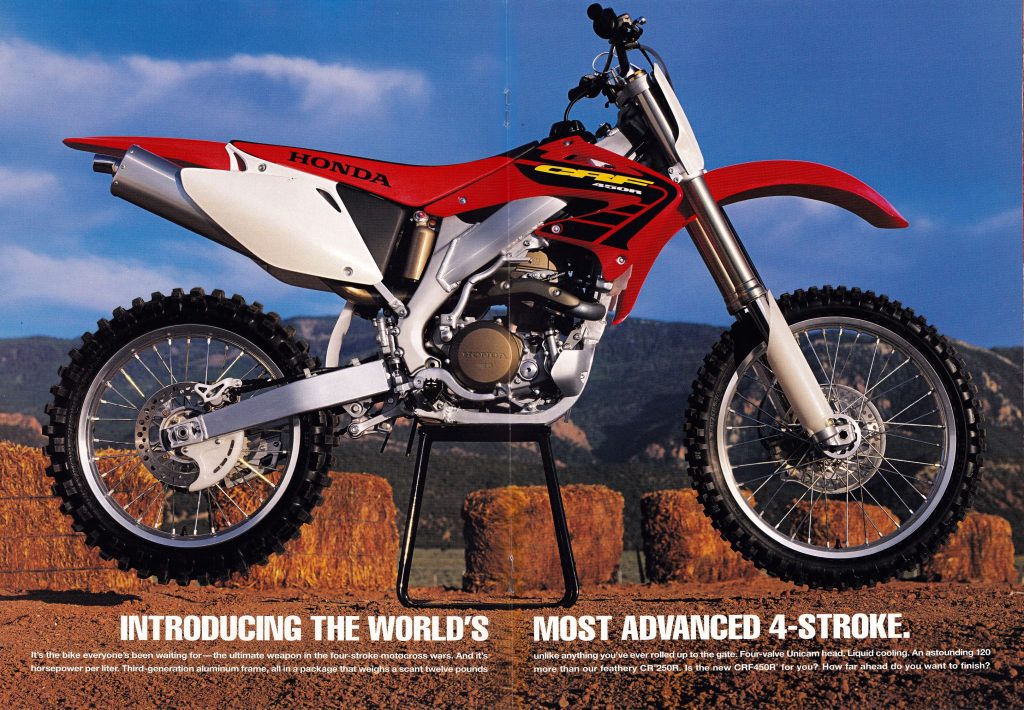 In 2002, Honda finally entered the high-performance four-stroke arena with the introduction of the first CRF450R. While not as potent as the YZ426F, the kinder and gentler Honda proved to be a massive sales success for Big Red. Photo Credit: Honda
In 2002, Honda finally entered the high-performance four-stroke arena with the introduction of the first CRF450R. While not as potent as the YZ426F, the kinder and gentler Honda proved to be a massive sales success for Big Red. Photo Credit: Honda
In 2002, the first real chink in the two-stroke’s armor arrived with the introduction of Honda’s all-new CRF450R. Introduced a full five years after Yamaha’s first YZF, the new CRF addressed many of the issues riders had voiced about the first generation of Yamaha thumpers. The new Honda was lighter, sleeker, and more “two-stroke” like in its overall feel. There was less compression braking when the throttle was closed, and better throttle response when the throttle was opened. There was also no need for the Yamaha’s complex starting drill and the CRF was as easy to get on and ride as any two-stroke machine. While the motor was not remarkably fast and the chassis was slightly controversial, people snapped up the red thumpers in droves. Nearly overnight, tracks across America were a sea of red four-stroke machines.
 When designing the CRF450R motor Honda took a very different approach than Yamaha had with their YZ-F line of machines. By using a single overhead cam, Honda’s engineers were able to reduce the weight of the motor and lower the engine’s center of gravity. The CRF also offered reduced compression braking compared to the Yamaha, less finicky starting, and spot-on carburation. Overall power output was not as awe-inspiring as the DOHC units employed on the YZ-F and the Unicam motor proved more maintenance intensive than the Yamahas, but for many riders the Honda’s combination of power, refinement, and ease of use were nearly impossible to beat. Photo Credit: Honda
When designing the CRF450R motor Honda took a very different approach than Yamaha had with their YZ-F line of machines. By using a single overhead cam, Honda’s engineers were able to reduce the weight of the motor and lower the engine’s center of gravity. The CRF also offered reduced compression braking compared to the Yamaha, less finicky starting, and spot-on carburation. Overall power output was not as awe-inspiring as the DOHC units employed on the YZ-F and the Unicam motor proved more maintenance intensive than the Yamahas, but for many riders the Honda’s combination of power, refinement, and ease of use were nearly impossible to beat. Photo Credit: Honda
In 2003, Yamaha introduced its answer to the CRF in the form of the all-new YZ450F. Redesigned from the ground up, the new YZF finally ditched the starting drill and added an all-new 449cc powerhouse of an engine. The chassis was all-new as well with the overall machine dropping an astonishing 13.5 pounds of weight from the year before. With its four-speed transmission, sharp handling, and aggressive power profile, the YZ450F was aimed squarely at motocross supremacy and the bike seemed more serious than the slightly laid-back CRF450R. The Honda’s milder motor, middle-of-the-road handling, and five-speed transmission made it the pick for many, but the new YZF proved that the 450 class was shaping up to be the most hotly contested in the sport.
 An all-new frame for 2005 offered a narrower pilot’s compartment and improved handling. Photo Credit: Kevin Duke
An all-new frame for 2005 offered a narrower pilot’s compartment and improved handling. Photo Credit: Kevin Duke
By 2005, the days of the 250 two-stroke as the dominant machine in motocross were starting to come to a close. The arrival of Suzuki’s all-new RMZ-450 four-stroke and the imminent release of Kawasaki’s KX450F all pointed to a valve-and-cam future. While all the major brands still fielded 250 two-stroke teams in Supercross in 2005, the transition to the 450s was well under way. The ‘05 season would also see the last of the major updates to the Japanese 250 two-stroke class with the introduction of the all-new alloy-framed YZ250. While Honda, Kawasaki, and Suzuki still offered 250 two-strokes in 2005, every one of them but the YZ250 would be gone within a few years. Clearly the writing was on the wall and Honda knew the 450 four-stroke class was about to get a lot more heated.
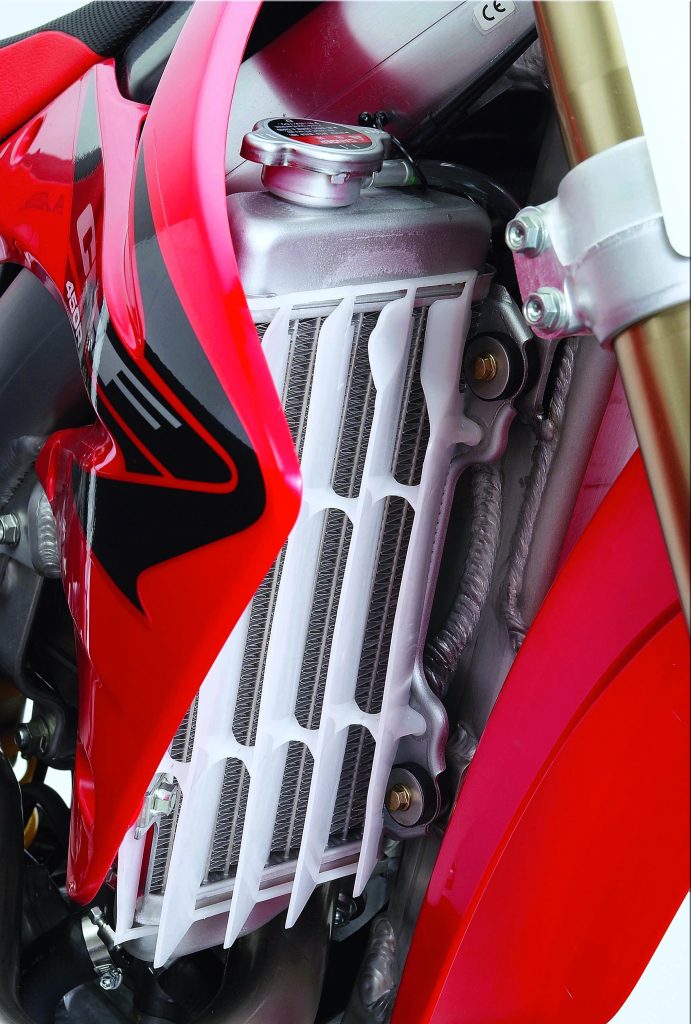 All-new radiators for 2005 offered improved cooling and a narrower profile to improve ergonomics and reduce the chance of damage in a crash. Photo Credit: Honda
All-new radiators for 2005 offered improved cooling and a narrower profile to improve ergonomics and reduce the chance of damage in a crash. Photo Credit: Honda
While the 2002 CRF450R was a tremendous success in the showrooms and on the track, it was not considered a perfect machine. Its airbox was cramped and prone to leaks, its motor was fairly mellow (and not as bulletproof as the Yamaha), its rear brake faded, and its turning was less than stellar. Two seasons of minor updates fixed the airbox leaks, sharpened the turning, and boosted the bark of Honda’s 449cc mill but it remained a milder version of the harder-core YZF. Some riders still felt the CRF was a bit too vague in the corners and a tad too soft off the bottom, but for most riders the 2004 CRF450R was the ultimate embodiment of the Open class ideal.
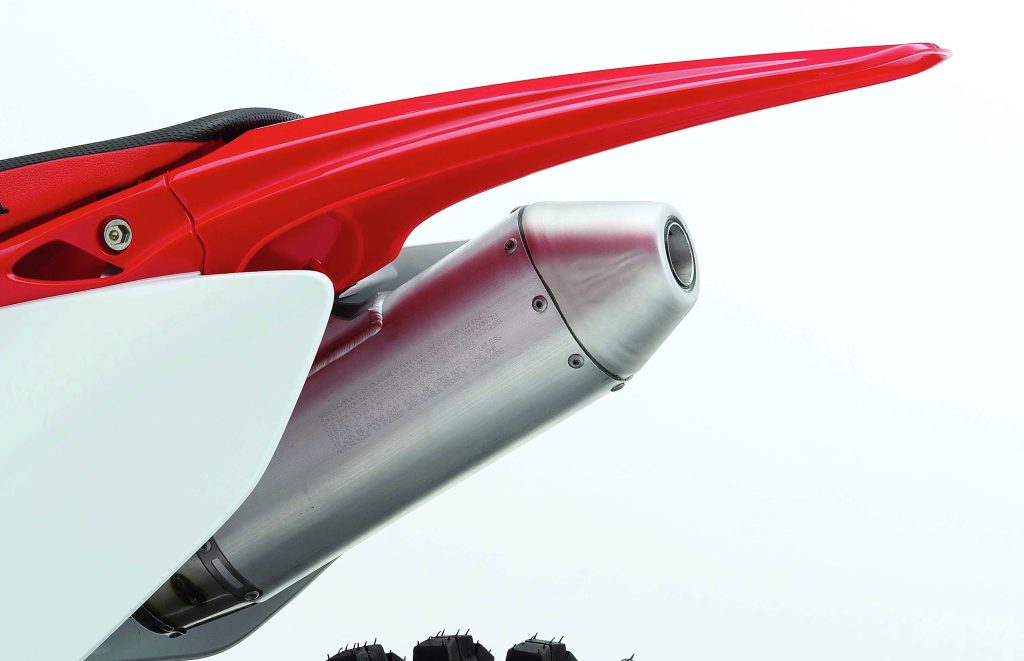 The CRF450R’s stock exhaust offered solid performance without being objectionably loud. Photo credit: Honda
The CRF450R’s stock exhaust offered solid performance without being objectionably loud. Photo credit: Honda
For 2005, Honda looked to bring a bit more verve to the reigning King of the 450 division. An all-new chassis aimed to sharpen the handling by shortening the wheelbase and redistributing the weight forward to improve steering feel. This new frame marked the fourth generation of Honda’s alloy perimeter design and shared much of its DNA with the chassis introduced on the all-new CRF250R in 2004. The redesigned frame increased the size of the steering head and repositioned it to place more of the machine’s weight on the front wheel. The new frame reduced rake and increased trail over the 2004 and narrowed the width of the main frame spars to increase rider comfort. The position of the front axle was moved 2mm rearward to shorten the wheelbase and increase steering precision. The alloy plates used to attach the swingarm were narrowed as well and repositioned to give the bike a thinner feel through the midsection. Both the radiators were redesigned to tuck in better and that along with the new frame provided a much thinner feel overall. Mated to the redesigned frame was an all-new swingarm that featured a dual-axis, double-tapered design that incorporated a cast aluminum crossmember for lighter weight and increased strength over 2004. Paired with the new swingarm was a redesigned Pro-Link linkage that featured a revised ratio for improved tracking in the rough.
 The introduction of an integrated rear master cylinder with reduced fluid capacity in 2002 saved weight but led to fading issues for many brake-intensive users. For 2005, Honda added a new insulator to the rear pads to keep fluid temperatures under control. Photo Credit: Honda
The introduction of an integrated rear master cylinder with reduced fluid capacity in 2002 saved weight but led to fading issues for many brake-intensive users. For 2005, Honda added a new insulator to the rear pads to keep fluid temperatures under control. Photo Credit: Honda
One of the major complaints with the first generation CRF was its absurdly cramped and difficult to access airbox. Leaking airboots, misaligned filters, and accidental dirt deposits into the intake tract were all well-known issues with this initial design. For 2005, Honda finally update the airbox to offer better access to the filter and increased airflow to the motor. The new design featured a slightly larger opening at the top, a straighter intake, and increased volume inside. Two large vents were added to the side plates to allow fresh air directly into the airbox for increased power.
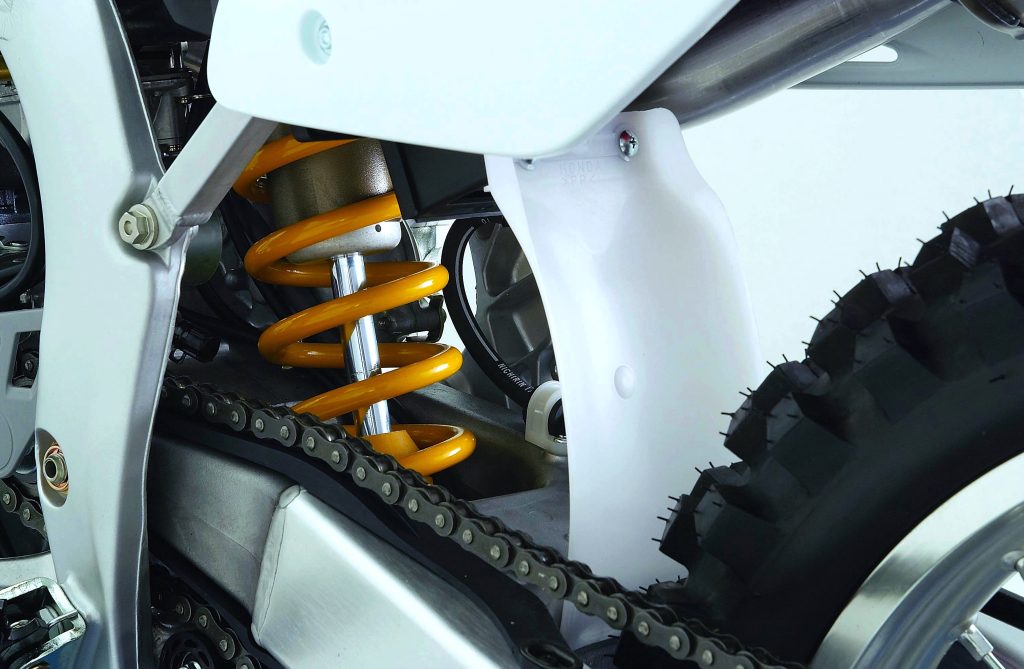 An all-new shock and redesigned linkage for 2005 promised improved performance. Photo Credit: Honda
An all-new shock and redesigned linkage for 2005 promised improved performance. Photo Credit: Honda
Another area of complaint with the original CRF was its predilection to overheat its rear brake under hard use. In 2002, Honda had redesigned the rear braking systems on all their full-size motocross machines to be lighter by reducing the size of the rear master cylinders. The new all-in-one design was lighter and much less prone to damage but lacked the fluid capacity of the older designs. While this seemed to work fine on the slower and lighter two-strokes, the big and powerful CRF could cook its brakes in a long moto.
 The new frame and revised bodywork reduced the width of the CRF’s riding compartment considerably for 2005. Excellent ergonomics and the best seat in the business made the CRF a tough package to beat. Photo Credit: Honda
The new frame and revised bodywork reduced the width of the CRF’s riding compartment considerably for 2005. Excellent ergonomics and the best seat in the business made the CRF a tough package to beat. Photo Credit: Honda
For 2005, Honda looked to address this issue by adding a special insulator between the pad and piston in the rear caliper. Disc size remained unchanged at 240mm and the master cylinder and reservoir remained incorporated into one unit. A new pedal was added as well to save weight over 2004. In the front the CRF continued to use Nissin’s proven dual-piston caliper design and 240mm front rotor. Long the industry standard, this Nissin combination was finally starting to feel the heat of competition from upstarts like KTM with their ultra-powerful Brembo components.
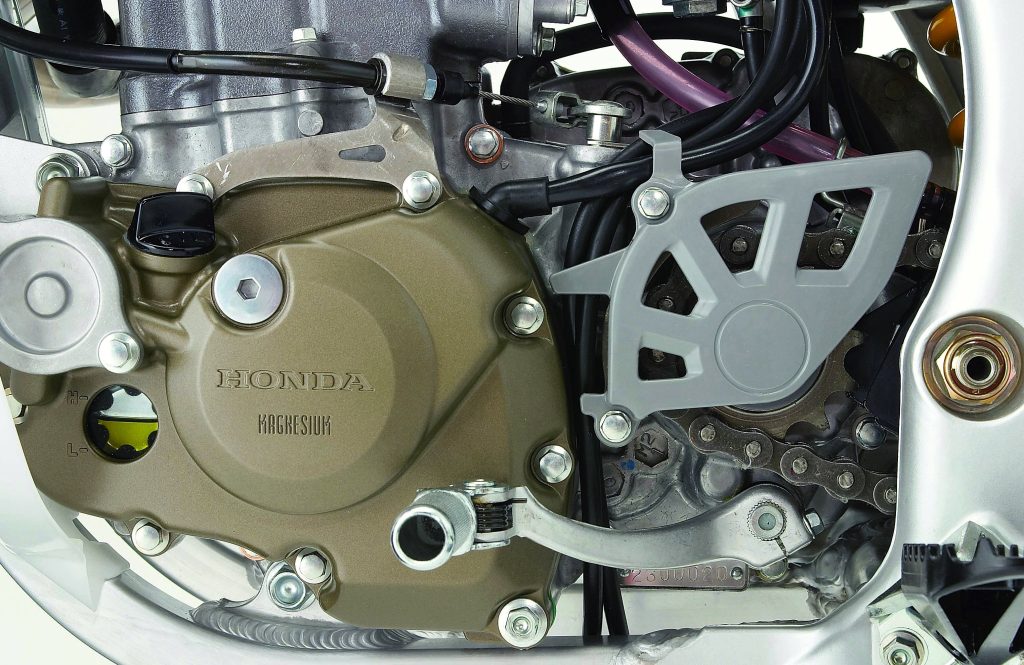 With substantially less oil capacity than the YZ-F, it was critical to check the CRF’s fluid levels before every ride. Photo Credit: Honda
With substantially less oil capacity than the YZ-F, it was critical to check the CRF’s fluid levels before every ride. Photo Credit: Honda
On the suspension front the CRF was a combination of old and new in 2005. Up front, the forks were largely a carryover from 2004 with a return of Showa’s excellent 47mm Twin Chamber units. After spending a decade in the wastelands of suspension ineptitude during the 1990s, Honda had finally turned around their fortunes in the early 2000s with a string of very solid performers. For 2005, new valving was the only notable change with the forks continuing to offer 12.4 inches of travel and 16 adjustable settings for compression and rebound damping.
 The CRF450R’s new frame for 2005 offered significantly improved steering feel over the first-generation machine. Here Factory Connection’s Kevin Windham demonstrates the CRF’s newly-found carving prowess. Photo Credit: Transworld MX
The CRF450R’s new frame for 2005 offered significantly improved steering feel over the first-generation machine. Here Factory Connection’s Kevin Windham demonstrates the CRF’s newly-found carving prowess. Photo Credit: Transworld MX
In the rear, an all-new shock was added that was designed to work with the new frame’s slightly lower mounting position. The new damper featured a longer shaft, a large 50mm piston for more consistent damping, and adjustments for high/low speed compression and rebound damping. All-new valving was added as well to work with the new linkage and revised chassis dynamics.
 An all-new airbox for 2005 offered improved airflow but remained frustratingly difficult to service. Photo Credit: Honda
An all-new airbox for 2005 offered improved airflow but remained frustratingly difficult to service. Photo Credit: Honda
On the appearance front, the 2005 CRF450R featured all-new bodywork that closely mimicked the looks of the 2004 CRF250R. This meant a sleeker overall profile with a flatter and narrower pilot’s compartment. The bike’s appearance was still distinctly “Honda,” but the new rear fender, seat, side plates, and shrouds offered a more unified appearance that most riders thought was an improvement over 2004. With standard Renthal handlebars, excellent switchgear, and a sano non-slip seat cover, the CRF was one of the most well-finished machines on the track in 2005. All told, the changes made to the CRF’s chassis for 2005 added up to an impressive 3.5 pounds in weight savings over the 2004.
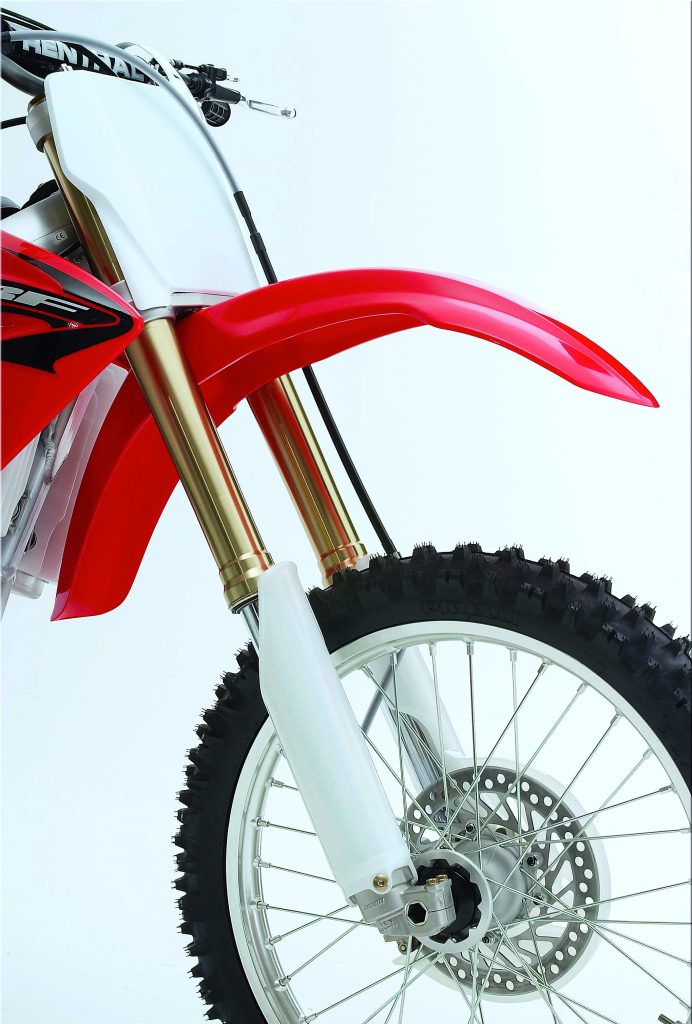 After a decade in the suspension Dark Ages, Honda came into their own in the early 2000s. Firmly damped but well controlled, the CRF’s 47mm Twin Chamber Showa forks were some of the best units available in 2005. Photo Credit: Honda
After a decade in the suspension Dark Ages, Honda came into their own in the early 2000s. Firmly damped but well controlled, the CRF’s 47mm Twin Chamber Showa forks were some of the best units available in 2005. Photo Credit: Honda
On the motor side of things, Honda chose to work on refinement rather than redesign in 2005. From its introduction in 2002, the CRF450R’s unique Unicam motor had been one of the most beloved powertrains in motocross. Relying on a four-valve head and single overhead cam, the Honda engine was very different than the five-valves and dual-overhead-cams found on the Yamaha YZF. Not as blisteringly fast as the Yamaha YZ-F, or as big-bore chuggy as the KTM 520, the CRF450R’s brand of power was more about usability than drama. It came on early, hooked up well, and was more than fast enough to get the job done. The motor offered the least compression braking in the class, flawless starting, a bulletproof clutch, and an easy delivery that was unintimidating to slow guys while still being fast enough to keep throttle jockeys happy. While perhaps not the raciest motor in the class, it offered a do-it-all style of power that quickly developed a loyal following among the masses.
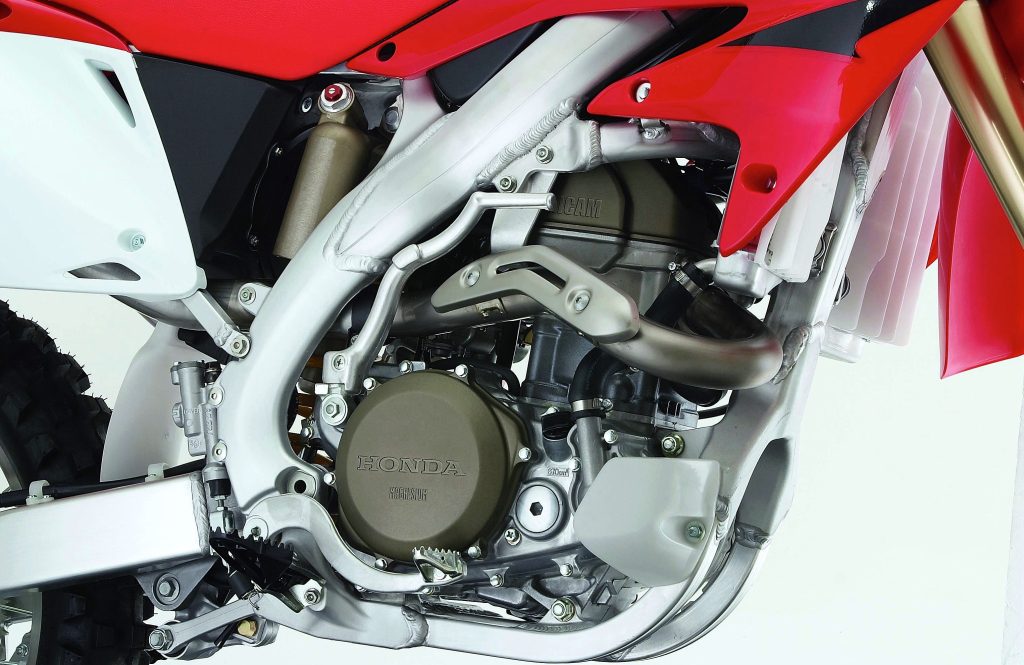 Minor motor updates added up to a winning engine package for Honda in 2005. Snappy out of turns, strong through the middle, and brawny on top, the CRF450R had all the bases covered. Photo Credit: Honda
Minor motor updates added up to a winning engine package for Honda in 2005. Snappy out of turns, strong through the middle, and brawny on top, the CRF450R had all the bases covered. Photo Credit: Honda
Knowing that they already had a proven winner on their hands, Honda left their 449cc mill largely unchanged for 2005. Internally, the top end of the motor remained untouched with a new shift drum, shift forks, and shift fork shaft making up the balance of the significant updates. As in 2004, the CRF450R remained a five-speed, which gave it some versatility advantages over the four-speeds found in the Yamaha, Suzuki, and KTM 450s. In addition to the transmission updates Honda also added a new titanium heat shield for the exhaust header and new mapping for the ignition. As in 2004, a 40mm Keihin FCR carburetor handled the mixing duties with an integrated “hot start” circuit to aid starting in the heat of battle. With its separate oil chambers for the top and bottom end, the CRF’s motor offered less room for error if you forgot to check the oil, but also less room for concern if something in the transmission or clutch let go and sent tiny pieces of metal floating through your motor’s lubrication system.
 Kevin Windham and his Honda CRF450R helped lead Team USA to victory in the 2005 Motocross des Nations. Photo Credit: Steve Bruhn
Kevin Windham and his Honda CRF450R helped lead Team USA to victory in the 2005 Motocross des Nations. Photo Credit: Steve Bruhn
On the track, the redesigned 2005 CRF450R turned out to hit nearly all of Honda’s targets with a marksman’s precision. The new chassis and more compact ergonomics made the bike feel even lighter than its 3.5-pound weight loss would have indicated. Turning was substantially improved and the CRF seemed to have finally exorcised the push that had annoyed many riders the previous three years. High and low-speed cornering were excellent, and the Honda finally felt on par with the Yamaha in the turns. Only the all-new Suzuki RM-Z450 proved to be more adept at changing direction in 2005. Perhaps even more impressively, it still enjoyed admirable stability at speed. Compared to a 250 two-stroke, the CRF still felt like a lot of machine but that additional power and heft rarely got you into trouble. It was a predictable and confidence-inspiring bike that did what you expected and rarely caught you off guard. If the CRF did get out of shape, it took a bit more muscle to bring it back than a two-stroke, but for a big and very powerful bike the CRF’s handling was excellent.
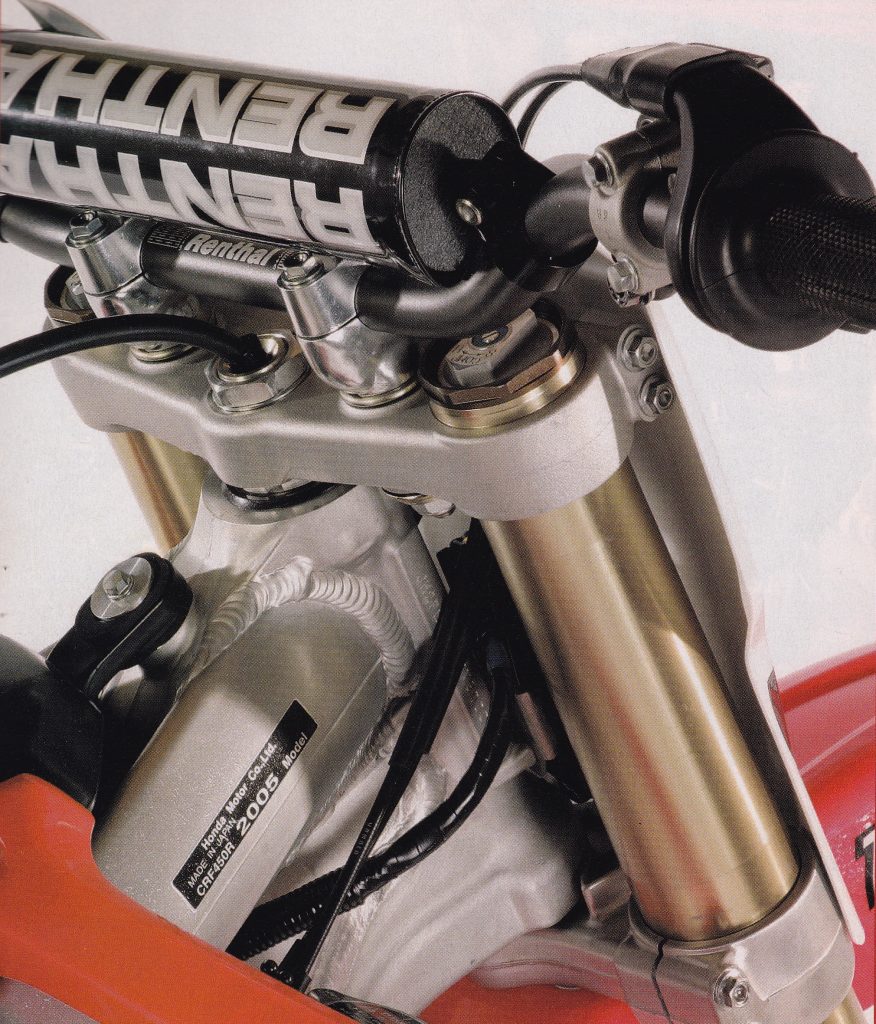 Standard Renthal bars were part of the CRF’s excellent fit and finish in 2005. Photo Credit: Motocross Action
Standard Renthal bars were part of the CRF’s excellent fit and finish in 2005. Photo Credit: Motocross Action
With only minor changes for 2005, the CRF450R’s engine was an improved version of the power plant riders had come to love over the previous three years. The new ignition and freer-flowing intake gave the Unicam motor a bit more snap out of the hole and a livelier feel under throttle. It was not eye-openingly faster than 2004, but the powerband felt racier and the motor more responsive for 2005. This increased roll-on power and added burst made the Honda’s already incredibly wide powerband even more effective on the track. Low-end, mid-range, and top-end output were all excellent with no dips, burps, or hesitations in the delivery. It was an incredibly flexible engine that worked well in extremely varied conditions. If it was slick, keep it a gear high and roll it on slowly and the Honda gripped like glue. If the track was deep and ripped, bang it down a gear and grab a handful of throttle and the CRF rocketed forward like an Open bike of old. It was an exceptional do-it-all powerband that pleased novices and pros with its ease of use and deceptively strong output. When you added in its relative lack of compression braking, its reluctance to flame out, and the versatility of its five-speed transmission, it was easy to see why the CRF was the pick of the motor field in 2005.
 Like the forks, the CRF’s excellent rear suspension offered class-leading performance in 2005. Photo Credit: Honda
Like the forks, the CRF’s excellent rear suspension offered class-leading performance in 2005. Photo Credit: Honda
On the suspension end of things, the CRF was once again a big winner in 2005. The works-style Twin Chamber Showa forks provided a solid ride that outclassed its rivals in overall feel and control. Big Jumps were taken in stride and the CRF offered excellent bottoming control in the rough. On small chatter the forks were not as plush as the Yamaha and Suzuki, but when the speeds ramped up the CRF pulled ahead. Some riders might have wanted a spring swap and the damping was a bit aggressive for off-road use, but for hard-core motocross the Honda was the choice in a very competitive field.
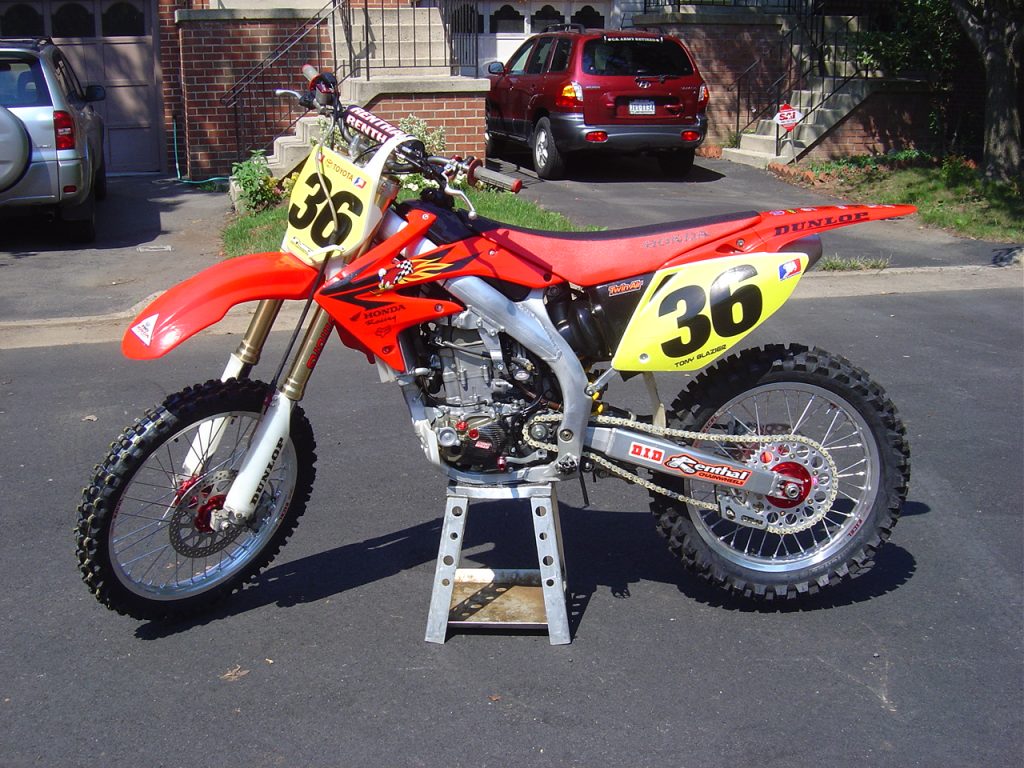 My personal 2005 CRF450R. I bought the first generation CRF450R in 2002 and while I enjoyed it, it was not nearly the machine this 2005 was. The ’05 felt smaller, lighter, leaner, and more serious without being too aggressive. I found it much easier to ride than the Yamaha and a great do-it-all machine. Photo credit: Me
My personal 2005 CRF450R. I bought the first generation CRF450R in 2002 and while I enjoyed it, it was not nearly the machine this 2005 was. The ’05 felt smaller, lighter, leaner, and more serious without being too aggressive. I found it much easier to ride than the Yamaha and a great do-it-all machine. Photo credit: Me
Out back, the new Showa shock garnered the Honda another gold star for performance. Most riders loved its admirable combination of compliance and control. As with the forks, the shock’s settings skewed more towards the aggressive end of the spectrum with a firm feel that inspired confidence at speed. The new rear end held up much better on hard hits than in 2004 and the bike could be trusted to not do anything crazy if you mistimed a jump and screwed up the landing. Big whoops and big air were no issue and the CRF’s shock worked better the harder it was pushed. Some slower and lighter riders found it a bit stiff, but the shock’s overall action was rated the best in the class.
 Aerial antics were no problem on the CRF450R in 2005. Great power, excellent suspension and a relatively light feel made the Honda a joy to jump. Photo Credit: Honda
Aerial antics were no problem on the CRF450R in 2005. Great power, excellent suspension and a relatively light feel made the Honda a joy to jump. Photo Credit: Honda
On the detailing front, the CRF450R was highly rated for the most part in 2005. With its alloy frame, excellent-quality plastic and durable graphics, the CRF still looked new long after the Yamaha appeared tattered. Its super-comfortable seat also felt like gift from the moto gods after a short stint on the rock-hard saddles installed on the Yamaha and KTM. Stock Renthal bars and excellent switchgear gave the CRF a premium feel but its Nissin binders still trailed behind the ultra-powerful Brembo units found on the KTM. At least the new pad insulators did lessen the fade problems at the rear for 2005.
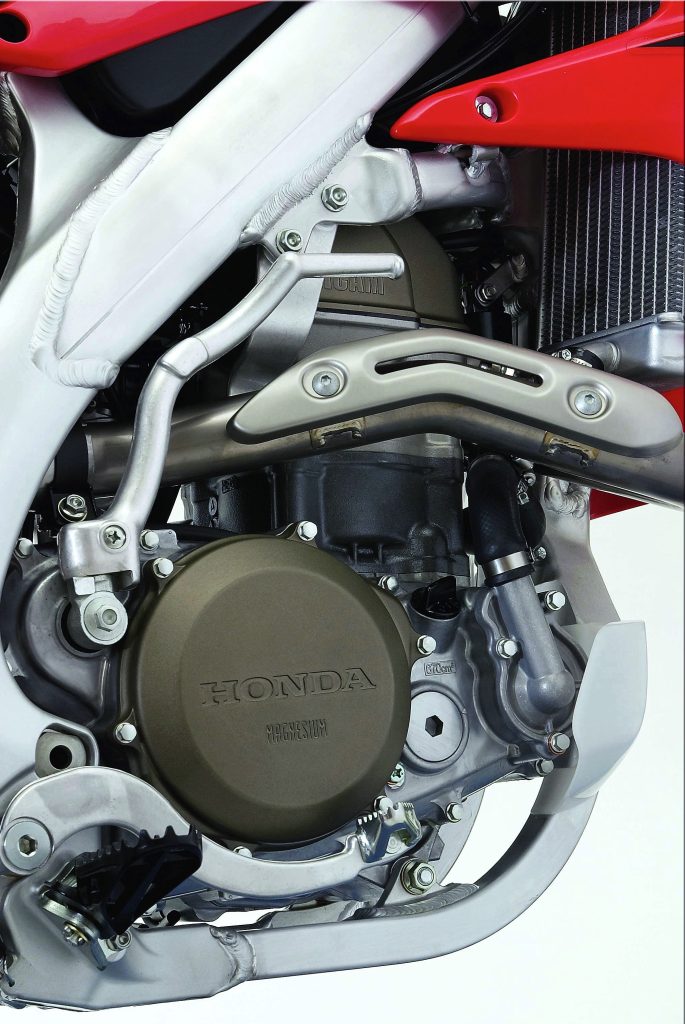 Early thumpers could be a nightmare to start but the CRF’s reliable and easy starting helped win over thousands of riders leery to make the four-stroke jump. Photo Credit: Honda
Early thumpers could be a nightmare to start but the CRF’s reliable and easy starting helped win over thousands of riders leery to make the four-stroke jump. Photo Credit: Honda
While beautiful and durable, the Honda’s slick alloy frame did make maintenance more of a pain than on some of the other machines. The frame spars blocked access to many components and just changing the jetting was a major operation. The new airbox continued to be a major pain with the enlarged opening still not allowing enough room to easily remove the filter. It was all but impossible to get a dirty filter out without dropping some debris inside the airbox and care had to be taken not to deposit grit where it did not belong. With its relatively small oil capacity, it was also critical to keep an eye on the CRF’s oil level. The big thumper liked to sip a fair amount of precious lubricant and checking the level before every ride was a must-do if you wanted to avoid a very costly failure. It was also important to not mix up the two oil chambers which used very different types of lubricant.
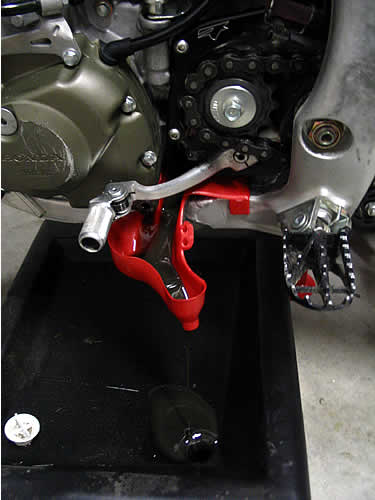 While generally well thought out, the CRF’s difficult to access oil drains made changing its fluids a messy and aggravating procedure. Thankfully, companies like Billywho were quick to design special funnels to make this critical task less frustrating. Photo Credit: Thumper Talk
While generally well thought out, the CRF’s difficult to access oil drains made changing its fluids a messy and aggravating procedure. Thankfully, companies like Billywho were quick to design special funnels to make this critical task less frustrating. Photo Credit: Thumper Talk
Changing and filling those oil reservoirs was also a messy business unless you invested in a special funnel to aid in this operation. A company named Billywho made a killing selling “Man Funnels” to address this annoying problem (the best $15.99 you could spend on a CRF). Even if you kept up with the oil maintenance, however, the CRF proved less durable than the Yamaha. Valve life was far less than on the YZ-F and it was important to service its Unicam top end regularly to ensure proper operation. It was certainly not a time bomb like the early Kawasaki/Suzuki 250Fs, but it was also not the “change the oil and forget it” machine that people had come to expect with the Yamaha four-strokes.
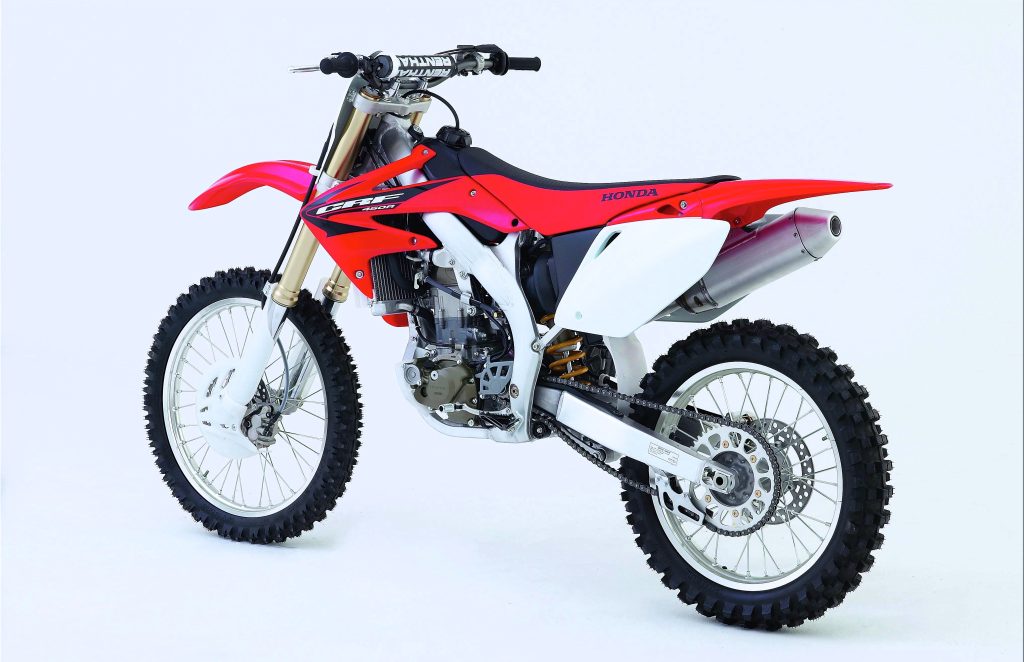 While not perfect, the 2005 Honda CRF450R was about as close to the ultimate Open class machine as you could hope to get in 2005. Photo Credit: Honda
While not perfect, the 2005 Honda CRF450R was about as close to the ultimate Open class machine as you could hope to get in 2005. Photo Credit: Honda
Overall, the redesigned 2005 Honda CRF450R turned out to a be lighter, trimmer, and more hard-edged version of the machine the buying public had fallen in love with the three previous years. Even for two-stroke die-hards, it was hard to deny the excellence of Honda’s big 450. In an ever-growing field of four-stroke competitors, the CRF450R stood out as a bike that won over even people who didn’t like four-strokes. Well suspended, great handling, light (for the time), and blessed with an unbeatable combination of power and usability, the CRF450R set the standard for racing four-stroke performance.






